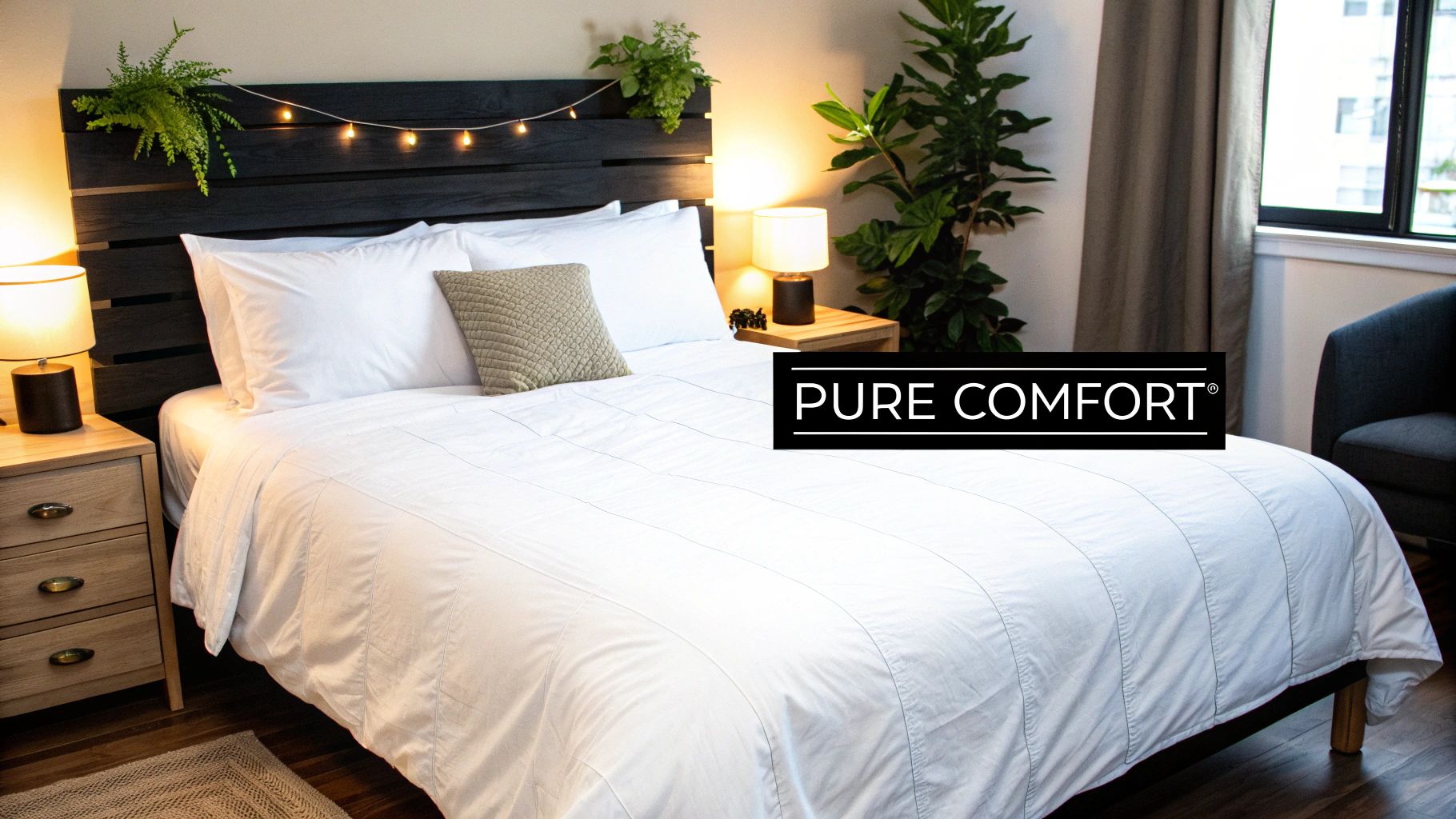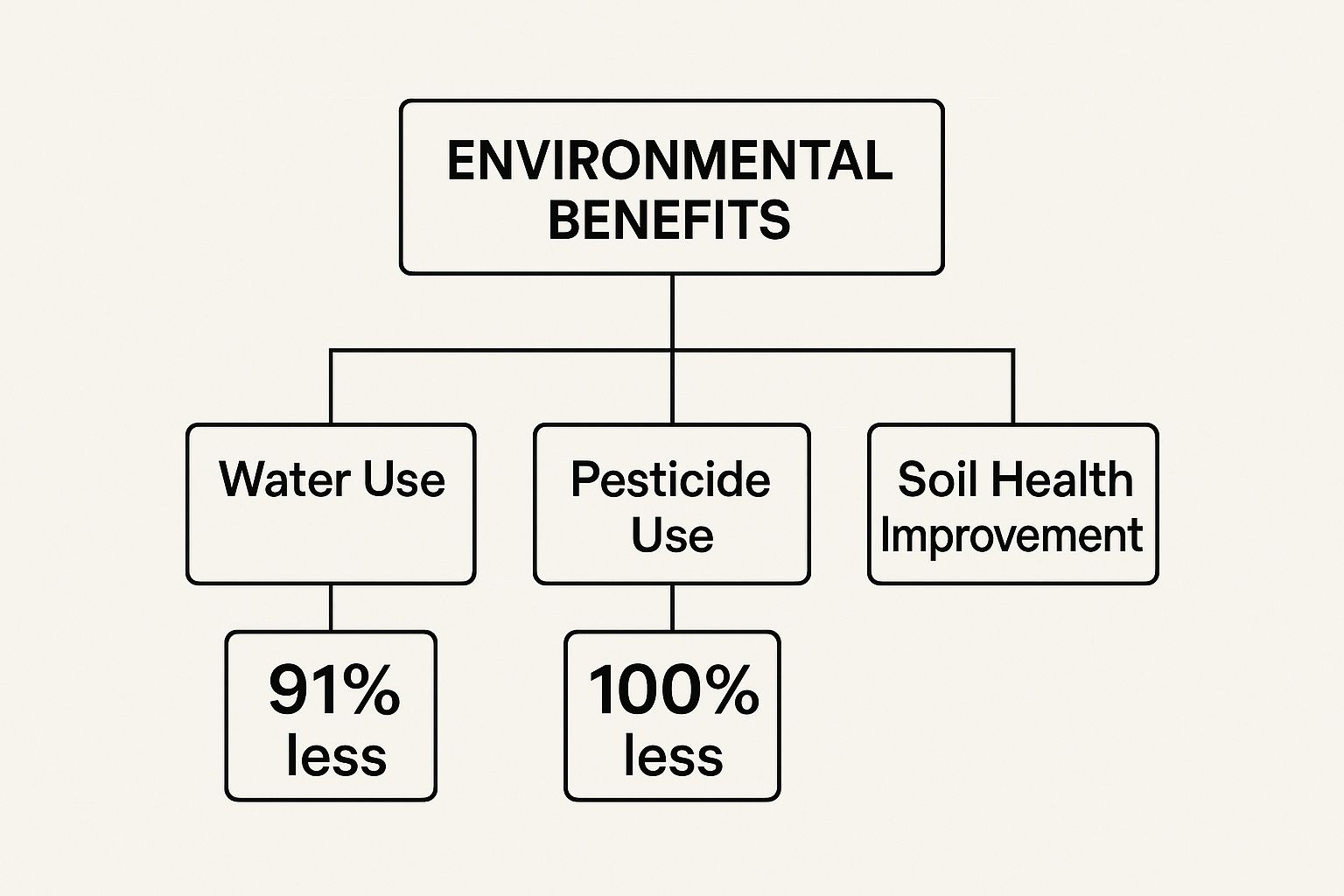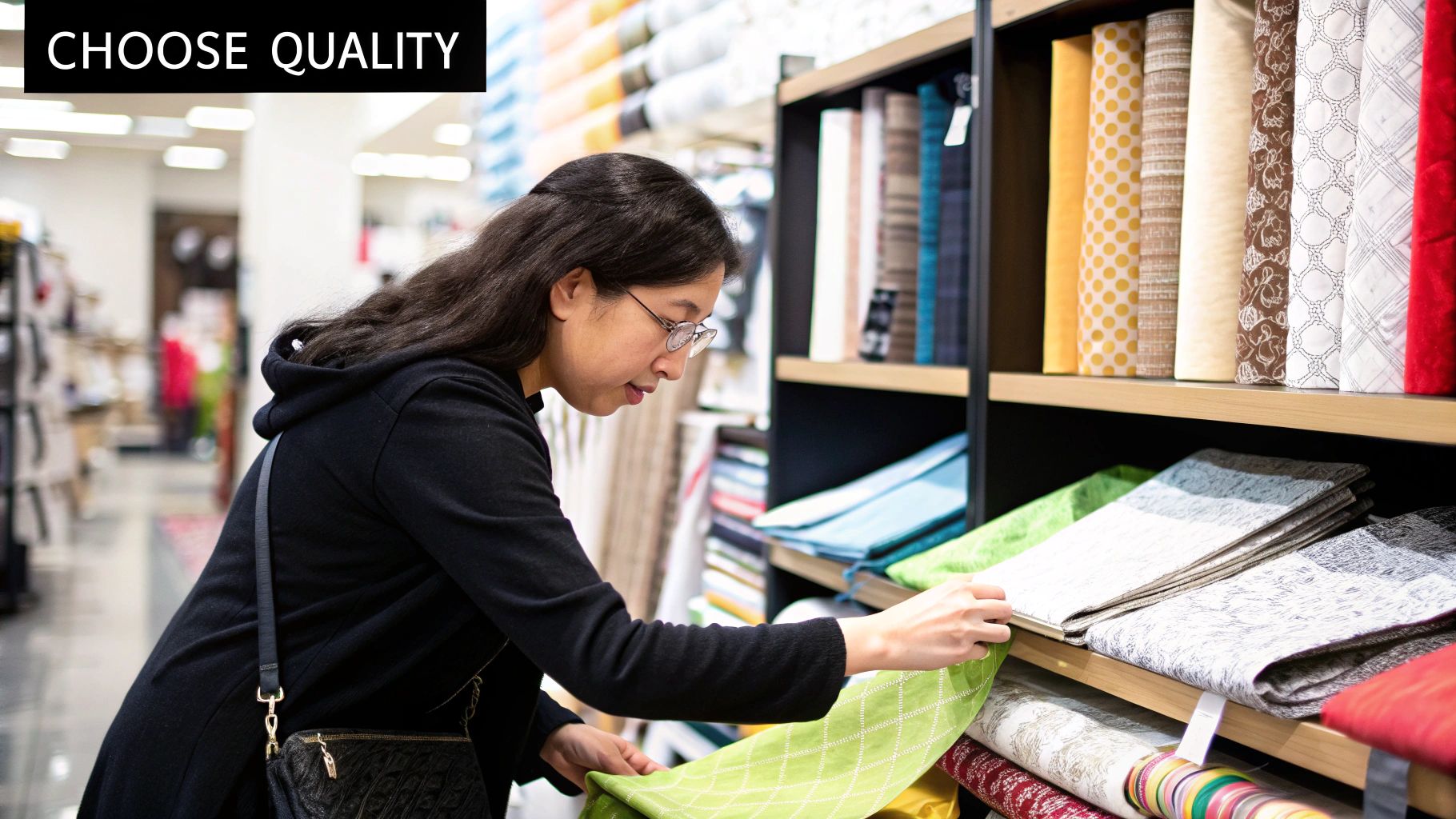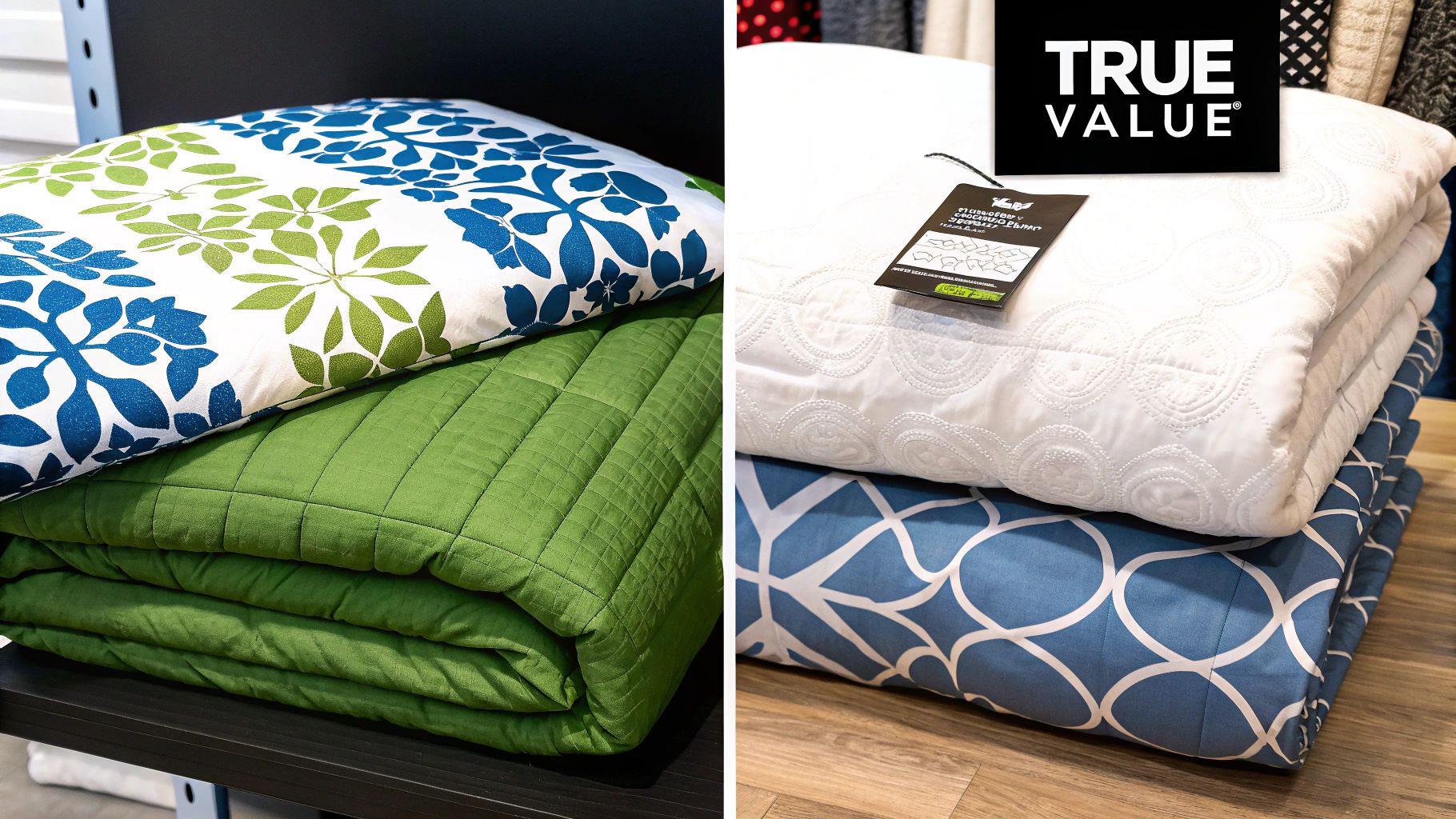In the simplest sense, organic cotton bedding is just that—bedding made from cotton that’s grown completely free of synthetic pesticides, fertilisers, and genetically modified organisms (GMOs). But that definition only scratches the surface. Choosing organic is a real commitment to purity, giving you a final product that’s much kinder to both your skin and the environment.
What Is Organic Cotton Bedding, Really?
A great way to think about organic cotton is to compare it to the produce at your local market. On one side, you have organic fruit and vegetables, grown in harmony with nature. On the other, you have conventionally grown produce that often relies on a cocktail of synthetic chemicals to get the job done. This core difference in philosophy creates a ripple effect that influences everything from the health of our soil to the final feel of the sheets against your skin.
At its heart, the story of organic cotton is about what’s left out. Conventional cotton farming has a pretty bad reputation—it’s often called the world's 'dirtiest' crop for a reason. It's responsible for a huge chunk of global insecticide and pesticide use. These harsh chemicals don't just stay in the fields; they can seep into waterways, degrade soil quality, and even leave trace residues on the very fabric you sleep on.
The Organic Difference from Seed to Sheet
Organic farming turns this entire model on its head. Instead of fighting against nature, it works with it to build healthy, fertile soil and manage pests naturally. It’s a return to smarter, time-tested practices, including:
- Crop Rotation: By alternating the crops they plant, farmers can naturally replenish soil nutrients and disrupt pest cycles without reaching for a chemical spray.
- Composting: Rich, natural compost is used to fertilise the soil, feeding it the way nature intended, rather than using synthetic formulas.
- Beneficial Insects: Farmers introduce good bugs, like ladybirds, to act as natural predators, controlling pests without any harmful side effects.
This holistic approach means the cotton fibres themselves are never exposed to harsh chemicals, right from the moment the seed goes into the ground. This purity is carefully preserved throughout the manufacturing process, especially when you see that coveted GOTS (Global Organic Textile Standard) certification on the label.
The essence of organic cotton is its clean journey. From a non-GMO seed planted in healthy soil to a final fabric woven without toxic dyes or finishes, every step prioritises natural integrity and ecological balance.
Why This Matters for Your Bedroom
Bringing organic cotton bedding into your home isn’t just an environmental statement; it’s a conscious choice for creating a healthier sanctuary. Think about it: because the cotton fibres haven’t been broken down or weakened by harsh chemical processing, they’re often stronger, softer, and more durable in the long run.
The fabric is also far more breathable and naturally hypoallergenic. This makes it a fantastic choice for anyone with sensitive skin or allergies, or frankly, for anyone just looking for a purer, more comfortable night’s sleep.
Here in New Zealand, where our connection to nature and a sustainable way of life is part of who we are, switching to organic cotton bedding feels like a natural extension of that mindful lifestyle. It’s an investment in your own well-being that also supports a healthier planet for generations to come.
The Real Health and Environmental Benefits

Choosing organic cotton bedding is about so much more than just a good night's sleep. It's a conscious decision that benefits your own health and has a genuinely positive impact on the planet. Think of it as a choice with ripples—from the comfort of your bed all the way back to the farm where the cotton first grew.
The first and most personal benefit is for your skin. Conventionally grown cotton is often treated with a cocktail of harsh chemicals, dyes, and even finishing agents like formaldehyde to keep it wrinkle-free. These residues can linger in the fabric, meaning your skin is exposed to potential irritants for eight hours every night.
Organic cotton, on the other hand, is handled with care. It's processed without these aggressive chemicals, making it naturally hypoallergenic. This purity is a godsend for anyone with sensitive skin, eczema, or allergies. It’s not just about what’s in the fabric, but also about what’s been deliberately left out.
A Healthier Night's Sleep
When you sleep on organic cotton, you’re creating a healthier, more breathable space. The natural fibres allow air to circulate freely, which is brilliant for regulating your body temperature. It wicks moisture away to keep you cool and dry on warm nights, yet feels cosy and warm in the winter.
This natural breathability also makes your bed a less inviting home for dust mites and other allergens, which love damp environments. The result is a cleaner, fresher sleep, which can mean fewer sniffles and a much more restorative rest.
Choosing organic cotton bedding is a dual-purpose investment. You are simultaneously protecting your family from unnecessary chemical exposure while actively contributing to the restoration and preservation of the environment.
A Lighter Footprint on New Zealand's Environment
The environmental perks of going organic are massive. Conventional cotton is an incredibly thirsty crop, guzzling huge amounts of water. Organic farming, however, focuses on building healthy soil that retains moisture far more effectively. This simple shift leads to an incredible reduction in water use—often by as much as 91% compared to standard methods.
What's more, organic farming bans synthetic pesticides and fertilisers entirely. This is crucial because it stops toxic chemicals from running off into the groundwater and poisoning New Zealand’s precious rivers and streams. By choosing organic, you’re directly helping to protect our unique ecosystems and keep our waterways clean. If you're inspired, there are many other simple ways to live more eco-friendly around the home.
Building a Sustainable Future
This way of thinking is really taking hold here in Aotearoa. As a nation, we have a strong focus on sustainability, and more Kiwis are becoming aware of what they bring into their homes. The natural durability and breathability of organic cotton bedding offer year-round comfort, which fits perfectly with our desire for high-quality, sustainable living. You can explore more about environmentally friendly bed linen in New Zealand in our other guides.
Ultimately, choosing organic isn't just a shopping decision; it’s a vote for a better way of doing things. It supports a farming system that improves soil fertility, encourages biodiversity, and helps lock carbon into the earth instead of releasing it into the atmosphere. Every set of organic sheets is a small but powerful step toward a healthier world.
How To Spot High-Quality Organic Bedding
Trying to find truly high-quality organic cotton bedding can feel a bit like navigating a maze. Every brand promises unparalleled luxury, but how do you know what’s real? The good news is, there are a few key things to look for that cut through the marketing fluff. Once you know what to spot—from official certifications to the feel of the cotton itself—you can invest wisely in comfort that genuinely lasts.
The first step is to look for proof. Don't just take a brand's word for it. This proof comes from globally recognised certifications that act as your guarantee, verifying that the bedding meets strict environmental and social standards all the way from the farm to your bedroom.
Decoding The Labels: Why Certifications Matter
When you're shopping, you’ll mainly see two certifications on top-tier organic bedding: GOTS and OEKO-TEX. While both are excellent signs of a responsibly made product, they guarantee very different things. Getting your head around the difference is key to picking bedding that truly aligns with your values.
Here's a quick guide to the most common certifications you'll encounter.
Understanding Bedding Certifications
A comparison of the most common textile certifications to help you identify truly organic and safe bedding.
| Certification | What It Guarantees | Focus Area |
|---|---|---|
| GOTS | The entire product journey is organic—from farm to factory. No pesticides, no harmful chemicals in processing, and fair labour practices are enforced. | Organic Process |
| OEKO-TEX Standard 100 | The finished product is safe for human health. It's been tested and found free from a list of over 1,000 harmful substances. | Product Safety |
The takeaway here is simple but crucial. GOTS is the gold standard for truly organic textiles. It's the one to look for if you want assurance the cotton was grown and processed without nasty chemicals. OEKO-TEX, on the other hand, is all about the safety of the final product you bring into your home.
You can think of it this way: GOTS certifies the entire organic journey, while OEKO-TEX certifies the safety of the final destination. For the ultimate peace of mind, look for bedding that has both.
Beyond Thread Count: The Real Signs of Quality
For years, we’ve been told that a high thread count is the ultimate sign of luxury sheets. While it's part of the story, it can be seriously misleading. The actual quality of the cotton fibres used is far more important than how many threads are crammed into a square inch.
The most critical factor is the cotton’s staple length. 'Staple' just means the length of the individual cotton fibres. Long-staple and extra-long-staple cottons (like Supima®) have fibres that are longer, smoother, and stronger. When spun into yarn, they create a fabric that feels incredibly soft and is much more resistant to pilling and tearing over time.
Honestly, a 400-thread-count sheet made from high-quality, long-staple cotton will feel more luxurious and last years longer than an 800-thread-count sheet woven from cheaper, short-staple cotton.

This image really drives home the environmental benefits you're supporting when you choose certified organic cotton. It’s not just about what you're avoiding (like pesticides), but also what you're contributing to—like massive water savings and healthier soil for everyone.
Choosing Your Weave: Sateen vs Percale
Finally, the weave is what gives your sheets their unique feel and finish. The two most popular choices for organic cotton are percale and sateen, and they offer completely different sleep experiences.
- Percale: This is a classic one-thread-over, one-thread-under weave. It creates that crisp, cool, matte finish you get in a luxury hotel bed. It’s incredibly breathable and just gets softer with every wash. Perfect for hot sleepers.
- Sateen: Woven with a three-or-four-over, one-under pattern, sateen has a silky-smooth feel and a beautiful, subtle sheen. It drapes elegantly and is naturally more wrinkle-resistant. It’s a great choice if you love a warmer, more luxurious feel.
Neither one is 'better'—it all comes down to personal preference. By focusing on certifications, fibre quality, and the right weave for you, you can confidently choose the perfect organic cotton bedding for a truly restorative night's sleep.
Shopping for Organic Cotton Bedding in New Zealand

Now that you know what to look for in high-quality organic cotton bedding, let's bring that knowledge home to New Zealand. We're lucky to have a fantastic selection of sustainable homewares here, but knowing where to start and what to expect price-wise will help you make a purchase you feel great about for years to come.
Here in Aotearoa, the shift towards more mindful and sustainable living is really taking hold. This is clear in the bedding aisle, where Kiwis are increasingly choosing organic options. In fact, over the last five years, imports and sales of organic cotton bedding have been growing by about 15-20% annually. By 2023, local retailers were reporting that organic varieties made up 25-30% of their cotton bedding sales—a massive leap from less than 10% just five years earlier.
This boom means more choice for you, whether you prefer browsing in boutique stores or shopping from the comfort of your couch.
Understanding Price Points in NZ
One of the first things you'll likely notice is that organic cotton bedding carries a higher price tag than its conventional cousin. It’s helpful to reframe this not as an extra cost, but as a true investment—in quality, ethical production, and a product that will last.
So, what are you actually paying for?
- Certification Costs: The GOTS certification is a thorough, farm-to-factory process. It's an expense for growers and makers, but it’s your best guarantee of genuine organic standards and fair labour practices.
- Fibre Quality: Bedding made from superior long-staple cotton like Supima® costs more because those fibres are rarer and create a fabric that is noticeably softer and far more durable.
- Weave and Finish: More intricate weaves, like silky-smooth sateen, and special finishing techniques that create softness without harsh chemicals all add to the production cost.
- Brand and Craftsmanship: Trusted New Zealand brands that have built a reputation for quality invest more in their materials, design, and ethical manufacturing.
Think of the price as a reflection of the true cost of making something well. It covers paying farmers a fair wage, protecting our environment from pesticides, and creating beautiful bedding that's designed to last for years, not just a single season.
Where to Find the Best Options
In New Zealand, you’ve got a few great avenues for finding organic cotton bedding. Specialised eco-homeware stores are brilliant if you’re someone who needs to see and feel the fabric first-hand. Their staff are often incredibly knowledgeable and can walk you through the differences between weaves and brands.
For a wider selection, online retailers are your best bet. Many local brands, like us at The Foxes Den, have curated online stores where you can explore entire collections, from crisp percale to luxurious sateen.
When you're shopping online, the devil is in the detail. Be sure to look for:
- Clear Certification Logos: Reputable brands will proudly display their GOTS or OEKO-TEX credentials.
- Detailed Fibre Information: The description should specify the cotton type (e.g., long-staple, Supima®) and the thread count.
- Weave Description: Look for clarity on whether it's percale, sateen, or another weave, so you know exactly the feel you're getting.
Ultimately, choosing organic cotton bedding in New Zealand is about aligning your purchase with your values. By focusing on certified, high-quality materials from retailers you trust, you’re not just buying sheets—you’re investing in a healthier home and a more sustainable world. It's a mindful choice we deeply appreciate, and you can read our thanks for being part of this journey.
Care Tips to Make Your Bedding Last
You’ve invested in beautiful organic cotton bedding, a choice that’s better for you and the environment. Now, let's make sure it lasts for years to come. A little thoughtful care is all it takes to keep those sheets feeling wonderfully soft and looking great.
The secret is to treat the natural cotton fibres with respect. They’ve already been spared the harsh chemicals during growing and processing, so it makes sense to continue that gentle approach in your laundry.
How to Wash Your Bedding the Right Way
Think of your organic cotton fibres a bit like your own hair. You wouldn’t use aggressive, stripping chemicals on it, and the same idea applies here. Harsh detergents and high heat can damage the cotton’s natural structure, making it feel less soft and wear out faster.
Always choose a cold or warm wash cycle—never hot. High temperatures can cause the delicate fibres to shrink and weaken over time.
Stick with a mild, eco-friendly liquid detergent. Powdered detergents can sometimes leave behind a residue that makes your lovely sheets feel stiff. Most importantly, give chlorine bleach and conventional fabric softeners a wide berth.
- Chlorine Bleach: This is far too harsh for natural fibres. It will weaken the cotton, making it brittle and prone to yellowing.
- Fabric Softeners: These coat the fibres in a waxy, chemical film. This blocks the cotton's natural pores, which ruins its breathability and moisture-wicking abilities—two of the best reasons you chose organic bedding in the first place!
By skipping the harsh chemicals, you’re not just protecting your sheets; you’re preserving the very qualities that make them so incredibly comfortable. You're letting the organic cotton breathe, stay soft, and regulate temperature just as nature intended.
The Best Way to Dry Your Sheets
How you dry your sheets is just as crucial as how you wash them. The absolute best method for keeping your organic cotton bedding in top condition is to line dry it. The sun is a fantastic natural sanitiser, and nothing beats the smell of fresh, air-dried sheets.
If you must use a dryer, always select a low-heat, gentle tumble setting. High heat is the number one enemy of cotton fibres, causing shrinkage and damage. A great trick is to toss a few wool dryer balls in with your sheets—they act as natural softeners, reduce wrinkles, and can even shorten the drying time.
Got a stubborn stain? You can often treat it naturally. A simple paste of baking soda and water applied to the spot before washing can work wonders. For tougher marks, try a solution of white vinegar and water. Just remember to test it on a hidden corner first.
Finally, proper storage is key. Make sure your sheets are completely dry before you fold and put them away in a cool, dry linen cupboard. This prevents any musty smells and keeps them fresh for their next use on your bed.
Want more tips? For a deeper dive, check out our complete guide on how to care for your cotton sheets to make them last.
Styling Your Bedroom for a Natural Look

Your organic cotton bedding isn’t just something you sleep in; it’s the heart of your bedroom’s entire look and feel. When you style your room around its natural beauty, you’re not just decorating – you’re creating a genuine sanctuary. It’s about building a space that feels intentional, mindful, and incredibly serene.
The best place to start is with your colour palette. Organic bedding truly comes alive in colours pulled straight from nature. Think of those soft, earthy tones like warm terracotta, a gentle sage green, or a calming stone grey. These shades immediately create a sense of peace and bring a little bit of the outside in.
Of course, you can never go wrong with a classic, crisp white. A set of pure white organic sheets is like the perfect blank canvas. It’s timeless, fresh, and makes any other textures or natural materials in the room really pop.
Layering Textures for Depth and Comfort
Want to create one of those beds that just looks irresistibly inviting? The secret is layering. This is where you can get creative and really show off the different qualities of your organic cotton weaves, adding depth and a cosy, touchable feel that makes you want to dive right in.
Think about how the different textures feel. You could start with a silky-smooth sateen fitted sheet for a luxurious feel against your skin. Then, add the light, crispness of a percale flat sheet and duvet cover on top for a beautiful contrast. To finish it all off, a chunky knit organic cotton throw or a textured waffle blanket draped over the end of the bed adds that perfect, final layer of comfort.
It’s an approach that makes your bed not only look stunning but feel absolutely incredible, too.
The art of a natural-looking bedroom lies in blending simplicity with richness. It’s about letting beautiful, natural materials do the talking through sophisticated colour choices and thoughtful, layered textures.
Bringing the Look Together
To really complete your peaceful retreat, you'll want to extend this natural philosophy beyond just the bed. By bringing in other natural materials around the room, you create a cohesive and calming space that feels truly put-together.
Here are a few simple ideas to get you started:
- Wooden Elements: A timber headboard, rustic bedside tables, or even a simple wooden bench can add so much warmth and ground the entire room.
- Woven Accents: Think about a jute rug underfoot, a wicker laundry basket in the corner, or a rattan light shade. These introduce more organic textures that pair perfectly with your bedding.
- Greenery: You can’t go wrong with plants! A few well-placed indoor plants literally bring life into the space, purifying the air and adding that final touch to your natural aesthetic.
When you make your organic cotton bedding the star of the show and support it with these simple touches, you can easily craft a bedroom that’s both chic and restorative. It’s a design that feels effortless yet deeply personal, turning your room into a true haven for rest and relaxation.
Your Questions Answered
It's completely normal to have a few questions after diving into the world of organic cotton. We get it. Choosing the right bedding is a big decision, and you want to feel confident you're making the best choice for your home.
To help clear things up, we’ve put together answers to some of the most common queries we hear from our customers right here in New Zealand.
Is Organic Cotton Bedding Really Worth the Extra Cost?
In a word, yes. While you might notice a higher price tag compared to conventional cotton, it’s helpful to think of it as an investment—not just in bedding, but in your well-being.
First, you’re investing in durability. Organic cotton fibres aren’t broken down by the harsh chemicals used in standard processing. This means they stay stronger for longer, so your sheets won't need replacing nearly as often.
You're also investing in your health. You’re essentially paying for the assurance that the fabric you spend a third of your life wrapped in is free from nasty chemical residues. For anyone with sensitive skin, allergies, or who simply wants a cleaner, healthier home, that peace of mind is priceless.
What’s the Difference Between GOTS and OEKO-TEX?
This is a fantastic question, and the answer is key to understanding what you're actually buying. They might sound similar, but they certify very different things.
GOTS (Global Organic Textile Standard) is the gold standard for anything claiming to be organic. It’s a holistic certification that covers the entire journey of the product—from the non-GMO seed in the ground to the final stitch on your duvet cover. It guarantees the cotton is grown organically, processed without harmful inputs, and made under fair labour conditions.
OEKO-TEX Standard 100, on the other hand, focuses only on the finished product. It tests the final item to ensure it’s free from a long list of substances known to be harmful to humans. So, while a product can be OEKO-TEX certified without being organic, a GOTS certification is your guarantee of a truly organic product from start to finish.
Will My Organic Cotton Sheets Shrink?
A little bit of shrinkage is totally normal for natural fibres, and organic cotton is no exception. You can generally expect your new sheets to shrink by about 3-5% over the first couple of washes.
Don't worry, though—good brands know this. We design our bedding with this initial shrinkage in mind, so it will settle into the perfect fit. To keep it to a minimum, just stick to the care label. A cold wash and line drying (or a low-heat tumble dry) is always your best bet for keeping your sheets soft, correctly sized, and in beautiful shape for years to come.
Does a Higher Thread Count Mean Better Quality?
Not always! This is one of the biggest myths in the bedding world. While thread count (the number of threads woven into a square inch) has a part to play, what truly matters is the quality of the cotton fibre itself.
The secret to luxury bedding lies in 'long-staple' or 'extra-long-staple' cotton, like Supima®. These longer, silkier fibres are spun into a yarn that’s much smoother, stronger, and less likely to pill or wear out over time.
Think of it this way:
- A 400-thread-count sheet made from beautiful long-staple organic cotton will feel far more luxurious and last much longer than an 800-thread-count sheet woven from cheap, short-staple fibres.
- Sometimes, a high thread count can even be a negative, resulting in a fabric that feels stiff, doesn't breathe well, and breaks down quickly.
Instead of getting fixated on thread count, look for high-quality fibres and a trusted certification like GOTS. That’s a much more reliable sign of premium organic cotton bedding.
Ready to create your own sanctuary with bedding that is both beautiful and sustainable? Explore the curated collections at The Foxes Den and discover the unmatched comfort of our luxury linens.


